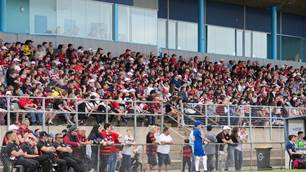Yes it’s that time of the year again, when teams begin their pre-season training. I’m sure older players (16 yrs and over) dread this time year. It is tradition on the east coast of Australia to take amateur senior players to the beach and “flog” them. Let’s examine the logic, benefits and science of getting players fit for a season and methods of player selection and testing.
The Nature of Football
Football is said to be one of the most physically demanding of all sports. Triathletes, mountain bikers, hockey players and marathon runners may disagree. My experience in SuperCross, MotoCross and even Karting, left me so exhausted, that I could not stand up after events. I was very fit, though, spending time in the gym, as well as practicing many hours a week training at home and on local tracks.
What is it that footballers do that makes it different from other sports? At the top level, players run an average of 9-10 kilometers during a game. That 10km distance involves explosive sprints over 10-20m, jogging, walking and a few sprints over 30m. Players jump, make rapid changes of direction, head, receive and kick a ball that has a small surface area when it makes contact with the body. It takes great skill to place the ball accurately with the feet, body and head. Playing football is difficult. Multi dimensional sports are difficult.
Reductionism v Holism and Conditioning
Reductionism has its place in science and coaching sport, however its use is limited in the real world. Events and actions do not take place in isolation, this includes human movement. Muscles work in synergy and can act as agonists when moving joints. To isolate a muscle weakness and prescribe a strengthening routine for that muscle can be dangerous. Why is the muscle weak? Does it have a proper nerve supply? Is the muscle compensating for other muscles? What about the biomechanics? What is the athlete’s training routine? Once these questions have been answered and other problems corrected, a functional movement exercise program can be prescribed. Activating muscle in context produces exceptional results in rehabilitation and performance.
Reductionist theories of football training attempt to break down the skills of a game into components. These components are then trained separately and usually in isolation and out of context, then put back together on the field. Robotically teaching players to do a particular action does not teach them when and why to do a particular action. Football is a complex sequence of movements and actions, with unlimited possibilities once 22 players enter a pitch.
“Holism” respects that every cell, tissue and system exists interdependently and co-dependently. The whole is greater than the sum of its parts. As mentioned in previous blogs, game based training allows the player to experience the game with less complexity than is realistic (similar to street football). In many ways, the coach has to be more skilled in teaching methodology and in observation skills, when using game sense training. The game is modified to create a learning environment. The game is further altered to produce outcomes and everything is learned at once in context. Instead of telling players what to do, they discover themselves. Reductionism in coaching is still useful but as an adjunct to Holism.
Up until 15/16 years, coaches (under the NC) are not encouraged to formally condition their players. The reasons are quite specific. The nature of game based training is more than enough to increase fitness levels and the youth are still developing their physiological abilities (strength, power, VO2 Max etc.). Try game based training yourself and see what I mean.
Game based training replicates the real game. This is important for many reasons:
- Maximizes the time spent with players in a constructive and time efficient way as we typically only have 2-3 sessions per week to work with players
- Continues developing skill sets in a real environment
- Develops decision making abilities in our players
- Replicate real conditions so players improve and learn faster
What about older players? Players 16 years and over typically have a layoff of around 4 months for before training starts. Generally they are under conditioned, and have a few kilos to shed after extra “Christmas pudding”. Smart players will have put a training schedule in place that a coach has given them or play Futsal or 6/7 a side Summer Football. Traditionally the preseason is all about getting players fit in a rapid time. High intensity and high repetition conditioning systems do not make physiological sense. The overload component in pre-season is unscientific and unsafe. Biological systems take time to adapt to an environment. An unconditioned athlete placed into an out of context reductionist preseason training system is at real risk of injury. Knowing this, why would any coach place an unconditioned athlete in an unplanned high intensity training program? When do we see most of the injuries occurring?
Humans generally seek activities that give us pleasure. This appears to be based around chemicals called dopamine and serotonin. These chemicals are released in the brain, which stimulates the pleasure centres. The athlete generally finds preseason extremely unpleasant because low amounts of dopamine are released (preseason is associated with pain and deprivation). Add a ball, some goals, competition and the experience for the players dramatically changes. ie more enjoyment = more dopamine = happier players.
In the Real World
I observe junior and youth coaches at training, wasting their time playing unrelated games, without the ball (Snakes and Ladders or Ring -Around- The -Rosie approaches) or make great elaborate explanations about a simple concept, when their players desperately require technical training with the ball, in a game centered environment. It gets worse with adult players, who are thrashed up and down sand dunes, and put on long runs followed up by ridiculous core strength exercises when the athlete is unfit. This is only a recipe for injury (remember these amateur athletes have to also perform at school and work during the week). I see players boxing into punching bags on the field. Not a ball in site. I never see punching bags or sand dunes on football fields! What is the rationale? These thoughtless activities keep occurring, because somebody just made it up or somebody follows the leader, or it is what the coach experienced as a player? Is this logical and/or scientific?
There are some constraints on doing game based conditioning however. Cricket season, Council requirements and weather, place restrictions on field usage. Perhaps the beach or gym is the only alternative. It does bring a pleasant change of environment which may create a psychological boost for your players. I have been in such a position and the beach was the only environment in which to train. I did some sand hill training, invasion games, ball games, beach sprints and beach football. I tried to keep my training football related even in this environment. You have to be creative!
What is the Solution for Conditioning
For players over 16 years, a conditioning program is essential. Systems in the body are starting to mature. Below are some ideas and guidelines:
- Get base lines of fitness first, using game situations or testing
- Make a season plan with objectives and goals that are achievable based on your players skill and fitness levels. I use an Excel spreadsheet to make a periodized training program. Consider reading the references mentioned below to get ideas.
- Use the ball and games as your first choice to condition your athletes
- Introduce dynamic stretching routines and advice on pre and post training. Use static stretching only after sessions.
- Use proper warm ups and warm downs
- Gradually develop explosive power in your athletes once a baseline of fitness is achieved. 1v1, 3v3/4v4 on smaller fields is a great way to do this (sprints of 10m).
- Introduce core stability exercises during training and do them regularly
- Add agility and strength activities regularly
- Progressively increase training loads.
- Don’t over train
Be flexible and creative as a coach. Attempt to use game centered training as the majority component of improving your players conditioning levels, technical and decision making ability. Vary training every now and then with a different activity or environment.
Player Selection and Testing
How do we select our players and what criteria do we use to measure the effectiveness of our training programs? I have witnessed some of the most ridiculous testing criteria at community and representative clubs including dribbling in and out of cones, running in and out of poles, having no SSGs at all, and games of 20 per side on half a field in 30cm grass.
In the past, I have used a testing system developed by a professor at a German University which scored players based on standard deviations from a baseline score. The tests included movement, passing a ball against solid rebounders at 90 degrees from one another, sprints, agility tests with and without the ball and small sided games. The tests are a little awkward to use, so I developed another regime of tests to select and test players.
Player selection
Selecting players has a huge subjective component. What key points can we use to properly select our players? My advice is to take your time (at least 2 sessions) and give the players an opportunity to show what they can offer in a variety of game situations. Don’t use one session to select players. Objectively conduct a few tests to back up your subjective observations. At the very least, have a criteria for the small sided game component.
- Have at least one neutral party observing and assessing players and compare your notes.
- SSGs. 1v1, 4v4/5v5 to larger 8v8 games on half a field. Here you can add your criteria for selecting players. Watch what players do in game situations. Are they moving off the ball? How do they move? Watch their head movements. Do they open out when receiving the ball, do they have good technical skills. What is their attitude like to other players and to you?
- See if players are receptive to some coaching cues
- During games combine different players together
- Test sprint ability (10 and 30m), agility with and without the ball (see examples below)
Testing
Once a team is selected, conducting some regular testing is a fantastic way of setting benchmarks, encouraging and motivating players. It creates competition and gives feedback on your training program. Some of the tests listed below can be used for players 14/15 years but all of the tests can be used for 16 years and over.
- 10 and 30m sprint times. This is done with two stop watches in the one sprint
- Agility testing with and without the ball eg Arrow Head agility, or T test
- http://www.youtube.com/watch?v=bfkZReiQTIo&feature=related
http://www.youtube.com/watch?v=5BWa9cFGxhY&feature=related
- Turns with the ball in 30 seconds over a 10m area
- S.S.I.T Soccer Specific Interval Test. This test correlates very well with the beep test.
http://soccerfitacademy.com/research-creating-a-soccer-specific-interval-test/
http://www.youtube.com/watch?v=FDXar0NOoNc
- Other tests that may be relevant are the jump test. This is useful when using plyometrics in your training program (plyometrics should be part of a good training program and be football specific)
Do you have any criteria or tests you use with your players?
References to Consider
- http://soccerfitacademy.com/
- http://www.worldclasscoaching.com/productcart/pc/viewCategories.asp?idCategory=19
- Conditioning for Soccer Part 4 DVD with Foppe De Haan Reedswain Spring City PA USA 1997 (on old reference but very informative)
- van Lingen B. Coaching Soccer The Official Coaching Book of the Dutch Soccer Association Reedswain Publishing 1997
- Verheijen R. Conditioning for Soccer Reedswain Publishing Spring City PA USA 1998
- *Verheijen R. Het coachen van voetballen – het periodiseren van voetballen (amateur/professional) 2008, 2009 Drukkerij Hooiberg Salland
* These books will be available in English soon. Whilst not fluent in Dutch, my Dutch friends and an interpreting program helped me interpret these texts into English. I also attended Verheijen’s conference in Sydney in 2009
Related Articles

Pic Special: Western Sydney Wanderers vs Wellington Phoenix

Pic special: Jets v Mariners pre-season clash













